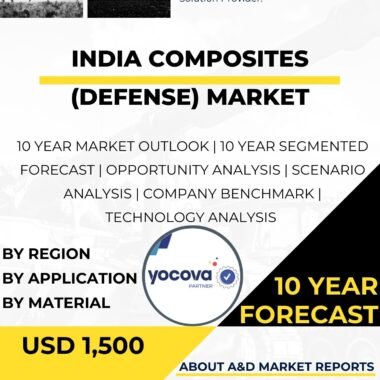Description
The composites market in Malaysia’s defense sector has emerged as a critical element of the country’s efforts to enhance its defense capabilities and modernize its armed forces. As a nation with geopolitical significance in Southeast Asia, Malaysia recognizes the importance of composites in the defense industry to improve performance, reduce weight, and increase durability across a range of military applications.
Composites are materials made from the combination of two or more distinct materials, typically a matrix and a reinforcement. In the context of defense, these materials can include fibers such as carbon, glass, or aramid, combined with a polymer matrix like epoxy, polyester, or thermoplastic. The resulting composite materials offer superior mechanical properties, corrosion resistance, and versatility compared to traditional materials like metals.
The use of composites in the defense industry has been on the rise due to their ability to provide lightweight yet robust solutions to various military challenges. The composites market in Malaysia has seen significant growth, driven by advancements in composite technologies, increased awareness of their benefits, and the desire to optimize defense systems’ performance.
One of the primary objectives of the composites market in Malaysia’s defense sector is to improve the performance of military equipment and platforms. By incorporating composites into the design of military vehicles, aircraft, and naval vessels, the country’s defense forces can benefit from reduced weight, increased structural integrity, and enhanced resistance to fatigue and wear.
The acquisition and integration of composites in defense systems are part of Malaysia’s broader defense modernization efforts. Collaborations with international defense companies and research institutions have facilitated access to advanced composite technologies and expertise. These partnerships have also allowed for technology transfer and knowledge exchange, contributing to the growth of the domestic defense industry.
Moreover, Malaysia has also demonstrated interest in developing indigenous composite capabilities. Collaborations between local defense companies and foreign manufacturers have facilitated technology transfer and knowledge exchange, fostering the growth of the domestic defense industry and contributing to economic development.
In addition to their application in military vehicles and platforms, composites play a significant role in the development of aerospace components. The aerospace industry relies heavily on composites to manufacture aircraft structures, wings, and other critical components. By incorporating composites in aerospace applications, Malaysia can enhance the performance and fuel efficiency of its aircraft, leading to reduced operational costs and environmental impact.
The composites market in Malaysia also extends to personal protective equipment (PPE) for military personnel. Composites are used to manufacture lightweight and high-strength helmets, body armor, and other protective gear, improving the safety and survivability of soldiers in the field.
Training and education are crucial aspects of the composites market in Malaysia’s defense sector. Proper training of defense personnel ensures that they are familiar with the properties, applications, and maintenance of composite materials. Regular training exercises contribute to enhancing the effective utilization of composites in defense systems.
Challenges in the Malaysian composites market include research and development investment, standardization, and supply chain management. Advancements in composite technologies require continuous research and development efforts to stay ahead of emerging threats and meet evolving defense requirements.
Additionally, standardization of composite materials and manufacturing processes is essential to ensure consistent quality and compatibility with existing defense systems. This standardization also helps streamline procurement and maintenance processes.
Furthermore, managing the supply chain for composite materials can be complex, as it involves sourcing raw materials, manufacturing components, and coordinating logistics. Ensuring a robust and reliable supply chain is critical to meeting defense industry demands.
The composites market in Malaysia is also influenced by international regulations and export restrictions related to dual-use technologies. Malaysia adheres to international regulations and guidelines to ensure responsible use and export of composite materials and technologies.
In conclusion, the composites market in Malaysia’s defense sector plays a crucial role in the country’s defense modernization efforts and capability enhancement. The adoption of advanced composite technologies enhances the performance, durability, and efficiency of military equipment and platforms. Collaborations with international partners and indigenous research and development efforts contribute to Malaysia’s strategic capabilities and the growth of the domestic defense industry. The government’s commitment to incorporating composites in defense systems demonstrates Malaysia’s dedication to enhancing its defense capabilities and addressing various security challenges. Additionally, the versatility of composites extends beyond military applications to support aerospace development, personal protective equipment, and various civilian industries, contributing to national defense, economic growth, and technological advancement.




